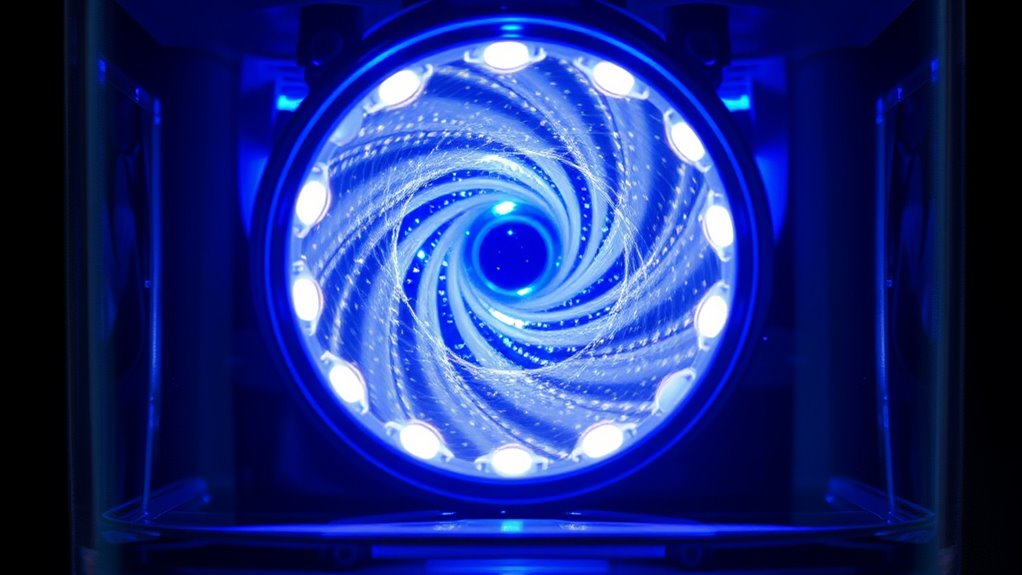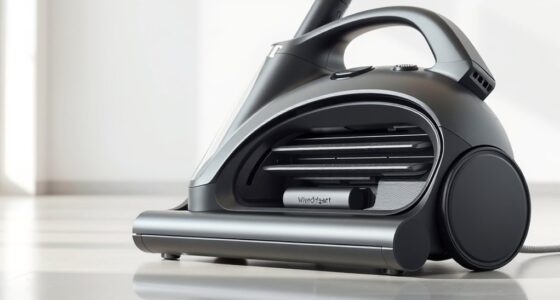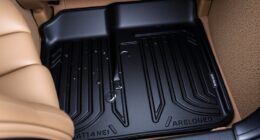Cyclonic vacuum technology works by spinning dust and debris outward using centrifugal force, which pushes larger particles into a collection bin while cleaner air moves through the center. This spinning motion keeps debris away from filters, reducing clogging and maintaining suction power. As a result, your vacuum performs more efficiently with less maintenance, and indoor air quality improves. To understand exactly how this science makes cleaning easier, keep exploring the details behind cyclonic design.
Key Takeaways
- Cyclonic vacuum technology uses centrifugal force to separate dust particles from airflow, enhancing filtration efficiency.
- The spinning chamber causes heavier debris to move outward and fall into a collection bin, reducing filter clogging.
- This separation maintains consistent suction power and prolongs filter lifespan, improving overall cleaning performance.
- The continuous cyclonic motion prevents debris buildup in hoses and filters, reducing maintenance needs.
- Physics principles like centrifugal force are applied to optimize airflow, durability, and indoor air quality.

Cyclonic vacuum technology revolutionizes how you clean by using centrifugal force to separate dust and debris from the airflow. Instead of relying solely on filters to trap dirt, this system creates a powerful spinning motion inside the vacuum, causing larger particles to be flung outward and away from the airflow path. As a result, the vacuum maintains high airflow efficiency because less dust reaches the filter, allowing it to work more effectively without clogging quickly. This design not only improves cleaning performance but also reduces the frequency of filter maintenance, saving you time and effort.
When you operate a cyclonic vacuum, the air enters a cyclonic chamber where it starts to spin rapidly. The centrifugal force pushes heavier particles like dust and dirt outward toward the walls of the chamber, where they fall into a collection bin or dust cup. Meanwhile, cleaner air continues to flow through the center of the chamber and towards the filter. Because the majority of debris gets separated early in the process, the filter is less burdened, which means it stays cleaner longer and retains its filtering capacity. This ongoing separation process ensures that your vacuum maintains consistent suction power, even after extended use.
The benefit of this system is that it minimizes the buildup of dust on the filter itself, which is a common issue in traditional vacuum cleaners. When filters get clogged, airflow drops, making your vacuum less effective and requiring frequent filter maintenance. With cyclonic technology, since less dust reaches the filter, you don’t need to clean or replace it as often. This not only extends the filter’s lifespan but also keeps your vacuum operating at peak performance with less upkeep. Plus, cleaner filters contribute to better indoor air quality, as they trap fine particles more efficiently, which is especially important if you suffer from allergies or asthma.
Furthermore, the design of cyclonic vacuums enhances airflow efficiency because the constant spinning action prevents debris from settling in hoses or on filter surfaces. The airflow remains strong, enabling you to pick up dirt and debris more effectively across different surfaces. This means you won’t have to go over the same spot multiple times, making your cleaning quicker and more thorough. Overall, the synergy between airflow efficiency and reduced filter maintenance makes cyclonic vacuum technology a smart choice for those looking for powerful, low-maintenance cleaning solutions. It’s a system that keeps your vacuum functioning at its best longer, saving you time, money, and effort while delivering superior cleaning results. Additionally, the science behind the system illustrates how physics principles are applied to enhance performance and durability.
Frequently Asked Questions
How Does Cyclonic Separation Improve Vacuum Efficiency?
Cyclonic separation improves vacuum efficiency by using a spinning airflow to remove dust and debris directly into a collection bin, preventing dust accumulation around the motor. This design reduces blockages and maintains suction power. As a result, your vacuum runs more effectively over time, which can extend the motor lifespan. You’ll notice less loss of power and better cleaning performance, making your vacuum more reliable and easier to maintain.
What Materials Are Best for Cyclonic Vacuum Components?
Ever wonder what materials keep your cyclonic vacuum performing at its best? You should choose components made from durable plastics or metals like aluminum or stainless steel. These materials resist wear and tear while maintaining airflow optimization. Isn’t it essential that your vacuum’s parts withstand frequent use? Selecting high-quality, sturdy materials ensures longevity, consistent performance, and efficient dust separation, making your cleaning routine smoother and more effective.
Can Cyclonic Vacuums Handle Wet and Dry Debris?
You might wonder if cyclonic vacuums can handle both wet and dry debris. Many models excel at dust collection and air filtration, making them versatile for different messes. However, not all cyclonic vacuums are designed for wet debris, so check the specifications. Generally, they work best with dry debris, maintaining strong airflow and separation efficiency, which keeps your space cleaner and improves air quality.
How Does Airflow Affect Cyclonic Separation Performance?
Airflow affects cyclonic separation performance by influencing airflow velocity and vortex stability. When airflow velocity is high, it creates a strong vortex that efficiently separates debris from the air. Stable vortex formation ensures debris stays in the cyclone, preventing clogs and maintaining suction power. If airflow slows or destabilizes, separation efficiency drops, reducing cleaning effectiveness. So, maintaining ideal airflow velocity is key to maximizing your cyclonic vacuum’s performance.
Are There Limits to the Size of Particles Filtered by Cyclonic Technology?
You might wonder if there are limits to the size of particles filtered by cyclonic technology. Filtration limits depend on particle size; larger particles are easily separated, while very fine particles can sometimes slip through. Cyclonic separators excel at removing bigger debris, but extremely small particles, like fine dust, may require additional filtration methods. So yes, there are practical particle size limits based on the technology’s design and efficiency.
Conclusion
Now that you understand the science behind cyclonic vacuum technology, you realize there’s more beneath the surface. This innovative design doesn’t just improve cleaning—it hints at future breakthroughs that could change how you see everyday appliances. As researchers continue to explore its potential, one question remains: what’s next for cyclonic power? Stay tuned, because what’s coming might just revolutionize the way you think about cleanliness—and the unseen forces at work around you.









